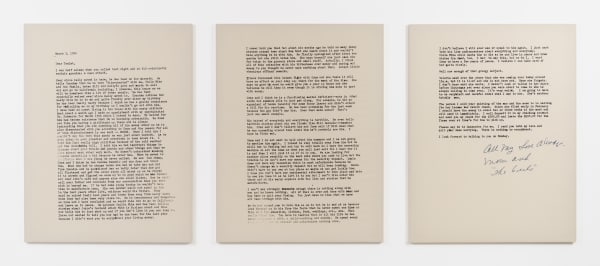On this page you can watch the film "Crackle & Drag" and find additional information about the work of TR Ericsson.
Ericsson's practice is one that tends to be shirt wet and hands dirty as it sings a mourning song. His epic project deals with love and loss, laughter and intimacy, struggle and grief. In many ways, the body of work he leaves behind is one of a life spent grieving, of looking back in order to navigate moving ahead with an emotional literacy that can be devastating, beautiful and necessary: A reminder that the end of the world is different every time.
-
The Film
A haunting epitaph of maternal and filial love structured around a series of biographical vignettes that document his mother’s life. The passing of time and distance are narrated by voice recordings she left on the artist’s answering machine in the mid 90's and early 2000's as she struggled with addiction, poverty and chronic illnesses. She died by suicide in 2003. Like most of Ericsson's work, this film is constructed using a combination of archival and originally shot material.
-

-

-

-

-
Related Works
-
 TR Ericsson, Coney Island Baby, 2018
TR Ericsson, Coney Island Baby, 2018 -
 TR Ericsson, Kirtland Road, 2014
TR Ericsson, Kirtland Road, 2014 -
 TR Ericsson, Can you hear her blacks crackle and drag?, 2018
TR Ericsson, Can you hear her blacks crackle and drag?, 2018 -
 TR Ericsson, Phone Bill, 2018
TR Ericsson, Phone Bill, 2018 -
 TR Ericsson, Poem to Morphine, 2015
TR Ericsson, Poem to Morphine, 2015 -
 TR Ericsson, Letter (March 3, 1994), 2019
TR Ericsson, Letter (March 3, 1994), 2019 -
 TR Ericsson, Letter opener (with bullet casings), 2017
TR Ericsson, Letter opener (with bullet casings), 2017 -
 TR Ericsson, Carbon Monoxide, 2015
TR Ericsson, Carbon Monoxide, 2015 -
 TR Ericsson, Scarecrow, 2012
TR Ericsson, Scarecrow, 2012 -
 TR Ericsson, Crackle & Drag Film, 2015
TR Ericsson, Crackle & Drag Film, 2015 -
 TR Ericsson, Bad Boy Billy Brat, 2008
TR Ericsson, Bad Boy Billy Brat, 2008 -
 TR Ericsson, Bride, 2019
TR Ericsson, Bride, 2019 -
 TR Ericsson, Job Master, 2019
TR Ericsson, Job Master, 2019 -
 TR Ericsson, Before the Devil Knows You’re Dead, 2020
TR Ericsson, Before the Devil Knows You’re Dead, 2020 -
 TR Ericsson, Coney Island, 2020
TR Ericsson, Coney Island, 2020 -
 TR Ericsson, Amitriptyline, 2017
TR Ericsson, Amitriptyline, 2017 -
 TR Ericsson, Autopsy, 2016
TR Ericsson, Autopsy, 2016
-





















